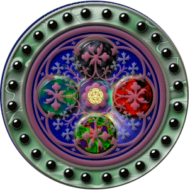For some time, the prevailing addiction around which my life turned was White Castle Hamburgers. I spent whole afternoons and evenings consuming one after the other. I would buy them by the sack, precooked and frozen, in order to save myself trips to the restaurant. Not that the restaurant was unpleasant. Its minimalist furnishings, its hermetic bullet-proof glass partition separating customers from employees—all lent the stark white cubicle a distinct charm. It seemed an appropriate locale for the production of a foodstuff which, far from being merely a source of nourishment, had become a virtual pastime, a fashion, a sensation… an idea.
“The taste some people won’t live without,” the television advertisements boasted. I would dwell on the nature of this taste, contemplate it as I slowly ingested the morsels, without ever coming to a satisfactory explanation of what it represented. These little wedges of significance, these pure potentiality pills—objectively, their taste was artificial, yet to me it came quite naturally. I succumbed to its hegemony.
The reheating instructions, printed on the side panel of each burger’s box, went from routine to ritual. After allowing them to defrost, I would obediently remove the burgers from their boxes and wrap them individually in aluminum foil. I would then heat them at 325° F, for 15 minutes. Full of anticipation, I would finally remove them from the oven, unwrap them and indulge myself, usually finishing off each burger in two bites. This I would do with four or five burgers at a time, at intervals of an hour or so, for perhaps six or eight hours a day. If I was pressed for time—in the morning, for instance—I would simply grab two or three already defrosted ones from the fridge and, like an astronaut, devour them cold. They were, after all, precooked, and the lack of heat did not detract from the essential taste; on the contrary, if anything, enhanced it.
This was my state of affairs when one day, I wandered into a theatre where several short films were being screened by some or another student activist group. Before I could fully realize what was happening, I found myself watching a french film called Blood of the Beasts, which graphically depicted the murder—in cold blood, and by the most brutal means imaginable—of a variety of higher mammals whose only crime was to comprise palatable dinner meat. The camera scrutinized every detail of the horrible slaughter—the binding of the animal’s legs, the pathetic look in its eyes, the animal collapsing as the axe penetrates its forehead, its throat slashed, blood pouring out, the removal of its flesh, the disembowelment. The butchers whistling as they worked.
I made my way home and stood dreamily in front of the refrigerator. I took out the sack of burgers, took one from its box and removed the top half of the bun. I had never uncovered a White Castle burger before—it seemed so impious. There—under a thin slice of pickle, splattered with ketchup, strewn with bits of onion—lay a tiny square patty. I stared at it for a while and began to feel queasy. How could anything so beautiful have been wrought from such carnage? Discarding the beloved victuals, I wondered.
